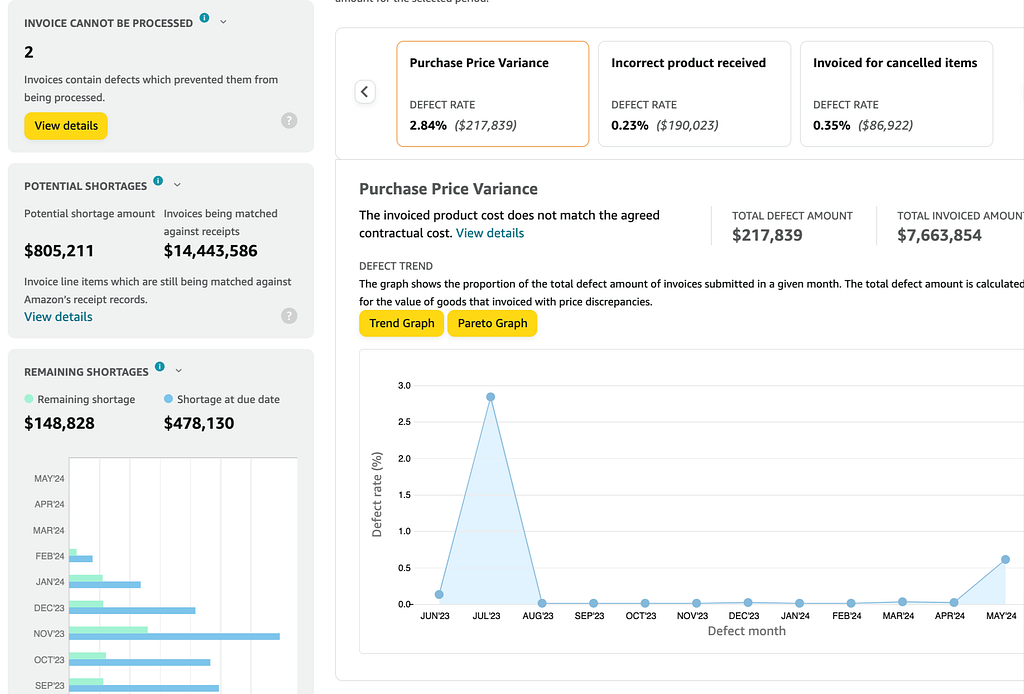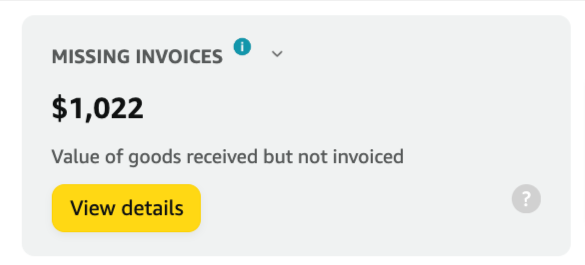Unlock the Secrets to Skyrocket Vendor Central Profits: Eliminate Devastating Financial Scorecard Defects Now!

Unlock the Secrets to Skyrocket Vendor Central Profits: Eliminate Devastating Financial Scorecard Defects Now!
Tips, how-to’s, and best practices to optimize the health of your Vendor Central financials
Managing financial transactions within Amazon Vendor Central can be challenging, especially when dealing with late or short payments.
This guide provides a detailed overview of the Financial Scorecard, the common issues it highlights, and the corrective actions vendors can take to ensure smooth and timely payments.
Overview of the Financial Scorecard
The Financial Scorecard offers an in-depth analysis of transactions between vendors and Amazon over a specific period. It helps vendors understand the reasons behind late or short payments related to invoicing, catalog discrepancies, and supply chain issues.

By using the Scorecard, vendors can identify potential gaps in their processes and receive guidance on addressing these issues to improve their business operations.
Common Issues and Corrective Actions
1. Missing Invoices

Issue Description:
- Instances where Amazon has received shipments but cannot locate the corresponding invoice.
Corrective Actions:
- Ensure an invoice is submitted when shipping products to facilitate timely payments.
- Avoid submitting invoices via paper or PDF, as these require manual processing and take longer to appear in the system.
- Ensure invoices comply with tax and compliance rules to prevent rejection.
- Do not submit duplicate invoices if one has already been sent.
2. Potential Shortages

Issue Description:
- Invoice line items are still being matched against Amazon’s receipt records.
Corrective Actions:
- If products have not been shipped, send them promptly or submit a credit memo to release the invoice for payment.
- If the shipment has already been sent, wait for the ongoing matching activities to be completed.
- If items cannot be matched to receipts, they will be moved to remaining shortages.
3. Remaining Shortages

Issue Description:
- Shortages during the payment dispute process after invoice matching and reconciliation.
Corrective Actions:
- Resolve or cancel remaining shortages promptly.
- Send shipments for the shortage quantity within the delivery window to receive payments.
- Submit a credit memo for the shortage quantity if the shipment was not sent.
- Contact Amazon to cancel the Shortage Claim Reversal (SCR) invoice. An SCR invoice lists all remaining unpaid items on an invoice.
Detailed Defects Overview
The Defect Overview provides further insights into specific issues and their resolutions:
Product Not Listed on PO
Issue Description:
- The product on the invoice is not on the purchase order (PO).
Corrective Actions:
- Short-term Solution: Send a credit memo and a new invoice with the correct items.
- Long-term Solution: Ensure invoiced products match the ordered ones and contact Amazon for catalog mapping verification if necessary.
Invoiced Quantity Greater Than Ordered Quantity
Issue Description:
- The invoiced quantity exceeds the quantity on the PO.
Corrective Actions:
- Short-term Solution: Submit a credit memo for the excess quantity.
- Long-term Solution: Ensure the invoice reflects the exact quantity ordered.
Unrecognized Product
Issue Description:
- The product ID on the invoice is not recognized in Amazon’s catalog.
Corrective Actions:
- Short-term Solution: Correct ID issues in the catalog and resubmit the invoice.
- Long-term Solution: Ensure the invoiced and shipped product ID matches the product ordered.
Multiple ASINs for a Single Product
Issue Description:
- The product ID on the invoice refers to multiple ASINs.
Corrective Actions:
- Short-term Solution: Verify and correct the product ID.
- Long-term Solution: Update product details regularly through Items > Edit Products.
Incorrect Unit vs Pack Quantity
Issue Description:
- The product quantity and cost specified on the invoice do not match the PO.
Corrective Actions:
- Short-term Solution: Verify consistency between the PO and the invoice.
- Long-term Solution: Regularly update product details to ensure accuracy.
Late Shipping
Issue Description:
- The shipment arrived at least 14 days after the product was invoiced or the invoice was due for payment.
Corrective Actions:
- Short-term Solution: Ensure timely delivery by coordinating with your carrier.
- Long-term Solution: Issue the invoice on the same day as dispatch and deliver within the PO delivery window.
Invoiced for Cancelled Items
Issue Description:
- Supplying products for purchase order items that were canceled before invoice submission.
Corrective Actions:
- Short-term Solution: Check internal data to verify the items sent and send a credit memo for incorrect items.
- Long-term Solution: Ensure timely delivery and avoid invoicing canceled items.
Incorrect Product Received
Issue Description:
- The received products differ from the invoiced products.
Corrective Actions:
- Short-term Solution: Send a credit memo for the wrong items and a new invoice with the correct items.
- Long-term Solution: Ensure the warehouse team ships products listed on the invoice and PO.
Deleted Appointment
Issue Description:
- The truck delivering the shipment failed to arrive or was rejected at the fulfillment center.
Corrective Actions:
- Short-term Solution: Ensure the carrier arrives at the correct delivery slot.
- Long-term Solution: Create valid appointments for truck deliveries and respect delivery dates.
Purchase Price Variance
Issue Description:
- The invoiced product cost does not match the agreed contractual cost.
Corrective Actions:
- Short-term Solution: Ensure no variance between the PO price and invoice price.
- Long-term Solution: Update product costs as soon as changes occur.
Liquidated Products
Issue Description:
- Delivered products not listed in Amazon’s catalog could not be received.
Corrective Actions:
- Short-term Solution: Send a credit memo for the wrong items.
- Long-term Solution: Ensure the warehouse team ships the products listed on the invoice and PO.
Overages Not Invoiced
Issue Description:
- Items shipped but not ordered or invoiced.
Corrective Actions:
- Short-term Solution: Verify the shipped quantity and submit an invoice for the correct quantity.
- Long-term Solution: Ensure the warehouse team ships the quantity of units confirmed in the PO.
Invoice Cannot Be Processed
Issue Description:
- Invoices containing defects preventing processing.
Corrective Actions:
- Short-term Solution: Check rejected invoices and correct the issues.
- Long-term Solution: Follow the correct guidelines to create and submit invoices.
Submitting a Credit Note (Memo)
When managing your financial transactions with Amazon Vendor Central, you may occasionally need to submit a credit note (memo) if an invoice is placed on hold due to a quantity shortage or price discrepancy. Submitting a credit note helps resolve these issues promptly and ensures your payment process continues smoothly.
Steps to Submit a Credit Note:
Navigate to Payments > Invoices:
- This section allows you to manage and review all your invoices.
Review/Dispute Shortages:
- In the Available Actions section, click on “Review/Dispute shortages”.
- This will allow you to select the specific invoice that requires a credit note.
Select an Action on the Invoice:
- Select the invoice in question and click on “Actions.”
View Invoice Details and Submit Credit Memo:
- In the Available Actions window, click on “View Invoice details”.
- Then, click on “Submit credit memo.”
- Note: You can create a credit note for the total amount or a partial credit note by clicking “Submit ASIN level details.”
Enter Required Details and Submit:
- Fill in the necessary details for the credit note.
- Once all details are entered correctly, click “Submit”.
Alternative Method via Financial Dashboard:
- You can also submit a credit note from the Financial Dashboard:
- Click on “In progress” under “Your payables.”
- Select the invoice that needs a credit memo.
- Choose “Submit credit memo” from the Available Actions drop-down menu.
Following these steps, you can efficiently manage discrepancies and ensure your invoices are processed without delays. Submitting credit notes promptly helps maintain a healthy cash flow and keeps your transactions with Amazon running smoothly.
Understanding Provisions for Receivables
Provisions for receivables are essential to managing your financial transactions with Amazon, mainly when dealing with returns, marketing expenses, and rebates. These provisions act as temporary credit memos, ensuring your account remains balanced even when forecasted costs exceed forecasted payments.
What are Provisions for Receivables?
Provisions for receivables are temporary credit memos that Amazon can place on your account. They are used when the forecasted costs associated with returns, marketing, and rebates due to Amazon exceed the forecasted payments owed to you. The primary purpose of these provisions is to prevent these costs from creating a debit balance on your account.
How Provisions Work:
- Deduction from Payments: Provisions are deducted from the payments due to you.
- Subsequent Adjustment: These provisions are subject to subsequent adjustments based on the actual costs of returns, marketing, and rebates, as well as the actual payments due to you.
Provision Placement:
- When a provision is placed on your account, it will be dated and displayed in the format YYMMDD_PROVISION_FOR_RECEIVABLES.
- For example, a date of 161017 on your remittance means that the provision was placed on October 17, 2023.
Reversing Provisions for Receivables
Temporary Nature:
- The provision for receivables will reverse when invoices for returns, marketing, and rebates are settled or when a decision is made not to return the inventory.
- When a provision is reversed, it will display as YYMMDD_PROVISION_FOR_RECEIVABLESR.
Daily Recalculation:
- Provisions are recalculated, adopted, or reversed daily.
- No invoice copies are associated with these provisions since they are not “real” deductions.
Understanding and managing provisions for receivables helps ensure that your account remains balanced and that you can accurately forecast your financial position with Amazon.
By keeping track of these temporary credit memos and their adjustments, you can maintain a clearer picture of your overall financial health and prevent any unexpected debit balances on your account.
Improving Your Financial Transactions
Vendors can significantly improve their financial transactions with Amazon by regularly reviewing the Financial Scorecard and addressing the issues it highlights.
Here are some general tips for maintaining smooth operations:
- Consistency: Always ensure that invoiced quantities and costs match those on the PO.
- Accuracy: Double-check all details before submitting invoices to avoid rejections and delays.
- Communication: Maintain open communication with Amazon to resolve any discrepancies promptly.
For further training and support, vendors can access additional resources through Vendor Central > Support > Training topics.
By understanding and utilizing the Financial Scorecard, vendors can minimize payment issues, streamline their invoicing processes, and enhance their overall business performance with Amazon.
Unlock Effortless Financial Insights With Our Code-Free Vendor Central Integration
Are you struggling with complex, messy financial data management for Vendor Central? Say goodbye to the hassle.
The Amazon Selling Partner API (SP-API) allows for direct, automated access to Amazon forecasting data, making it easier for businesses to integrate it into their systems. Openbridge allows Amazon Vendors to save time manually downloading reports, increasing data velocity and reducing errors in messy merging and tracking downloaded reports.
Openbridge automation extends beyond financial data to a broad collection of Amazon and non-Amazon data sources;
- Brand Analytics
- Retail Analytics
- Retail Procurement
- Direct Fulfillment
- Real-time Traffic, Sales, and Inventory
- Amazon Advertising
Openbridge offers a seamless, automated solution that unifies your data into a private, trusted data warehouse or data lake like Amazon Redshift, Databricks, Google BigQuery, and more — all without a single line of code. With your data unified, you can use your favorite analytic tools like Power BI, Looker, Tableau, and others for internal teams or external partners.
Automate And Unify Your Vendor Central Data — Free For 30 Days
Start your journey towards data-driven growth and profit with Openbridge. Our code-free, fully automated Selling Partner API integration simplifies your Amazon Vendor Central operations.
Ready to harness the power of your Vendor data?
→ Sign Up Now for Your Free 30-day Trial For Amazon Vendor Central Data Automation.
Unlock the Secrets to Skyrocket Vendor Central Profits: Eliminate Devastating Financial Scorecard Defects Now! was originally published in Openbridge on Medium, where people are continuing the conversation by highlighting and responding to this story.
from Openbridge - Medium https://ift.tt/NMFJPnO
via Openbridge